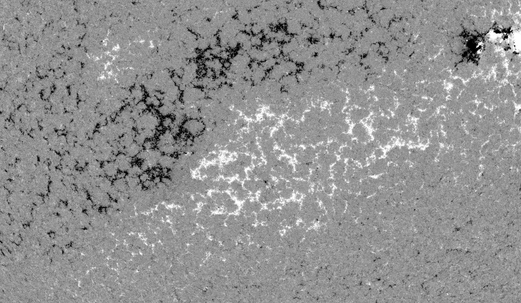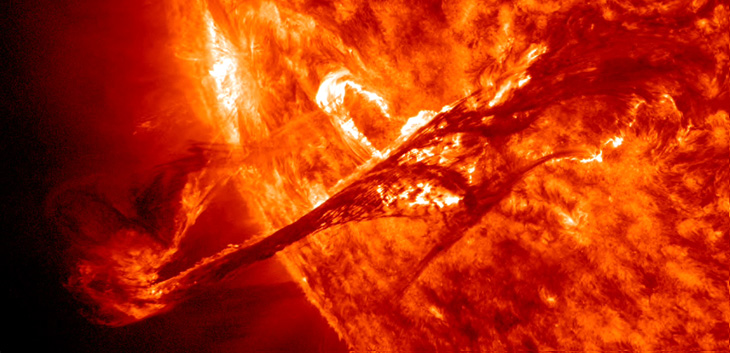Co to jest filament?
Solar filaments are clouds of ionized gas above the solar surface squeezed between magnetic regions of opposite polarity. Being cooler and denser than the plasma underneath and their surroundings, they appear as dark lines when seen on the solar disk. When a solar filament is seen near the solar limb with the blackness of space as background it is called a "prominence" instead.

Obraz: A filament as seen by NASA’s Solar Dynamics Observatory which is suspended between two areas of opposite magnetic polarity.
Solar filaments can last a long time before they disappear. Some survive for weeks! When solar filaments become unstable they can either fall back onto the Sun or erupt into space, sending a coronal mass ejection away from the Sun which can come towards Earth if the solar filament was well positioned. Just like coronal mass ejections produced by solar flares, a coronal mass ejection from a solar filament could also very well cause a geomagnetic storm on Earth. Space weather forecasters keep an eye on these filaments as they can be just as important as solar flares!

Obraz: A gorgeous filament eruption as seen by NASA’s Solar Dynamics Observatory.
Najnowsze wiadomości
Najnowsze wiadomości z forum
Wesprzyj SpaceWeatherLive.com!
Wielu ludzi odwiedza SpaceWeatherLive aby śledzić aktywność słoneczną lub sprawdzić czy jest szansa na zaobserwowanie zorzy polarnej. Niestety, większy ruch na stronie oznacza większe koszty utrzymania serwera. Dlatego, jeśli jesteś zadowolony ze strony SpaceWeatherLive, zachęcamy do wspierania nas finansowo. Dzięki temu będziemy mogli utrzymać naszą stronę.

Alerty
środa, 16 kwietnia 2025
21:45 UTC - Aktywność geomagnetyczna
Słaba burza geomagnetyczna G1 (Kp5) osiągnięty próg: 21:36 UTC
21:00 UTC - Aktywność geomagnetyczna
Bardzo silna burza geomagnetyczna G4 (Kp8) osiągnięty próg: 20:55 UTC
19:45 UTC - Aktywność geomagnetyczna
Silna burza geomagnetyczna G3 (Kp7) Osiągnięto próg: 19:25 UTC
19:00 UTC - Aktywność geomagnetyczna
Umiarkowana burza geomagnetyczna G2 (Kp6) Osiągnięto próg: 18:38 UTC
18:45 UTC - Aktywność geomagnetyczna
Słaba burza geomagnetyczna G1 (Kp5) osiągnięty próg: 18:28 UTC
Fakty na temat pogody kosmicznej
| Ostatnie rozbłyski klasy X | 2025/03/28 | X1.1 |
| Ostatnie rozbłyski klasy M | 2025/04/15 | M1.2 |
| Ostatnia burza geomagnetyczna | 2025/04/15 | Kp6+ (G2) |
| Dni bez plam słonecznych | |
|---|---|
| Ostatni dzień bez skazy | 2022/06/08 |
| Średnia miesięczna liczba plam słonecznych | |
|---|---|
| marca 2025 | 134.2 -20.4 |
| kwietnia 2025 | 124.1 -10.1 |
| Ostatnie 30 dni | 122.5 -17.8 |







